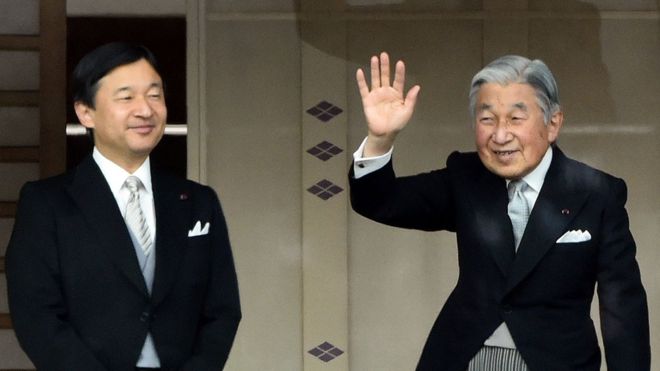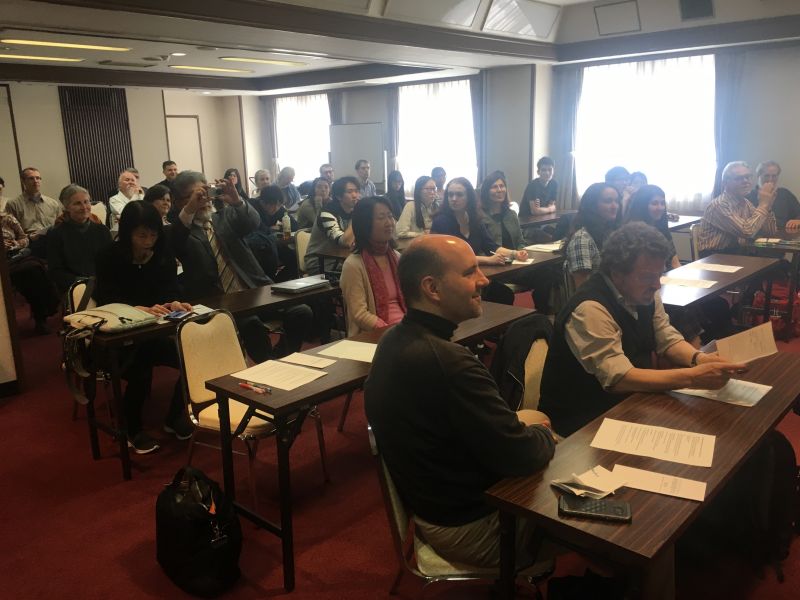
The past waves goodbye as the future prepares to take over. Emperor Akihito on the right, who will abdicate on April 30, and Prince Naruhito who will take over on May 1 (BBC photo)
ISSA is the International Shinto Studies Association, the head of which is emeritus professor Michael Pye based in Kyoto. In the past it’s been something of a shadowy organisation, with little attempt at outreach. Now however there seems a newfound sense of purpose with an updated website and a clear agenda – “We seek to combine a high standard of academic research into Shinto with a creative and socially responsible program of activities for the wider public,’ states Michael Pye in its publicity brochure.

Michael Pye, ISSA president, making introductory comments
In addition to Michael Pye as president, Mark Teeuwen (featured previously on Green Shinto) is a board member, as is Fabio Rambelli and Alexander Bennett. It was with great interest therefore that we learnt of an ISSA seminar in Kyoto on April 6, for it was on a most topical subject – the forthcoming enthronement ceremonies for the new emperor.
As readers may know, the present emperor Akihito is abdicating on April 30, the first emperor to do so for over 200 years, and his son Naruhito will be enthroned, with the new imperial era of Reiwa taking over from the former Heisei.
As the ISSA advertisement for the event put it, “In the course of the present calendar year of 2019 there will be several ceremonies relating to the enthronement of the new Emperor of Japan, Naruhito. Most important are the senso no gi 践祚の儀, the sokui no rei 即位の礼, and the daijōsai 大嘗祭.”
*********
The seminar consisted of three talks, the first by John Breen of Nichibunken on emperor-making ceremonies in Meiji, Taisho and Showa Japan. This was followed by Michael Pye on the separation of religion and state in postwar enthronement ceremonies, then finally Shinto priest Kato Taishi who spoke about the universality of Shinto in the enthronement ceremonies (Taishi’s talk will be covered in a separate post; he has featured previously on Green Shinto here).
As the speakers made clear, the basic procedure to install the new emperor is that an ascension ceremony, known as the Sokui rite, is followed at a later date in the autumn by a separate symbolic ceremony known as the Daijosai. This is said to be an elaborate form of harvest festival, during which prayers are offered for the well-being of the people and gratitude expressed for the yield of rice. However since it marks the sacralisation of the emperor, and the emperor is the symbol of the nation, the Daijosai is widely seen as the supreme Shinto ceremony in which the country asserts its divine origins. All members of the government attend, but no foreigners.

Kato Taishi, Shinto priest at Hattori Jinja in Osaka, currently working at Dazaifu Shrine in Kyushu
The symposium began with John Breen of Kyoto’s Nichibunken, who gave an overview of changes in post-Meiji enthronement ceremonies. Though the ceremony can be dated back to the 7th century, there was a 270 year gap when it was not performed. And as with nearly all Shinto matters, the Meiji Restoration of 1868 introduced a marked change from former ways – not so much a restoration as a radicalisation.
An example John Breen gave was the ceremony of Emperor Komei at the end of the Edo Era, which in Breen’s words was ‘thoroughly sinified’. However, the ceremony for his son Emperor Meiji was deliberately Japanese in tone. It also introduced the custom of a single era name being applied to a single imperial reign, whereas in former times the era name had been changed after misfortunes, in order to signify a fresh start – much in keeping with Shinto notions of renewal and purification.
Controversy has surrounded the enthronement ceremonies in postwar times because the Japanese constitution stipulates a separation of state and religion. Michael Pye said that there are no fewer than 240 legal cases being prepared to contest the ties of religion and state in the coming enthronement ceremonies. This raises the question of the distinction between ‘private’ and ‘public’ rites about which John Breen and Michael Pye apparently hold different views.
The issue is weighted in the government’s favour by a key court case in 1977 concerning the legality of a payment by a prefectural governor for a jichinsai ceremony. Religious rite or social custom? As the Kokugakuin encyclopedia puts it, the court ‘found that judgments on the religious nature of a certain act should be based on standard social conceptions, and must take into account the average person’s estimation of the religiosity of the act, and the intent and the expected effect of the act.’
In the opinion of the court, then, it all has to do with ‘intent and effect’. So find an average person and ask him if it’s a religious act or a Japanese custom – a question that could be asked across the whole range of what looks like religious behaviour in Japan. People visiting a shrine and paying respects, participants in a matsuri, buying the omikuji fortune, talking to the dead – ‘it is a Japanese tradition,’ is a standard answer.
*************

john Breen talking in front of a screen with the title of his talk, ‘Ritual interventions: Emperor-making in Meiji, Taisho and Showa Japan’
The Daijosai ceremony is an intriguing ritual involving two temporary halls, the Yuki-den and the Suki-den, in which there are beds. One school of thought is that the emperor ‘sleeps’ with the sun goddess in what Michael Pye described as ‘priestly marriage’ but which could also be seen in terms of ‘fossilised shamanic possession’. (The imperial household agency apparently denies that the emperor uses the beds during the night he spends in the halls.) Either way, it’s assumed that the emperor is communing with his ancestors.
The whole issue of the enthronement ceremonies thus raises some fascinating questions, given that until the end of WW2 the emperor was said to be divine. To what extent is the emperor considered to undergo transformation in the Daijosai? Is he simply honouring his ancestors, or is he becoming part of a sacred lineage? Is the ceremony a state ritual akin to coronation, or is it inherently religious? Indeed, is Shinto a religion at all (traditionalists claim it is part of the fabric of Japanese life)?
The question of who’s paying for the rites is thus a key point. According to Kunaicho, the imperial household agency, the cost of the Daijosai will be ¥2.72 billion of which the government will pay ¥1.8 billion. The new emperor’s younger brother, Prince Fumihito, made an unusual intervention by suggesting the private imperial budget should be used instead of public funds, which would necessitate a reduction of some 90% in expenditure. The scale of the event can be seen by the two grand banquets that are to be held, with a reduced number of 700 officially invited guests (down from the previous 900). This is after all the grandest ceremony of an imperial emperor in what is claimed to be the longest single ruling dynasty on earth.
(For details of the costs of the enthronement, see this Jiji news agency report.)

A full house, reflecting how interest in Shinto has grown in recent years

Leave a Reply